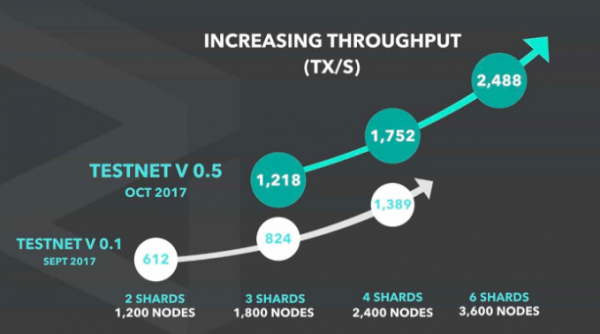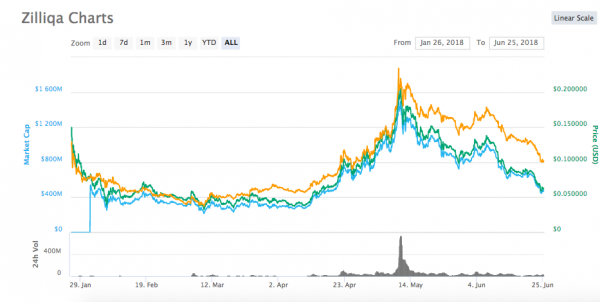Scalability is a problem that essentially every blockchain and distributed ledger technology project faces. Many solutions are being feverishly worked on, and one of the projects most aggressively chipping away on this particular block (no pun intended) is the next-generation, high-throughput blockchain platform Zilliqa.
In May 2018, Zilliqa joined an exclusive list of only 28 other cryptocurrencies to reach a market cap of over US$1 billion. This valuation is riding on the back of technology that presents itself as a solution to the scalability problems inherent to blockchain technology. It does so through the specific use of sharding, a partitioning technique that makes the processing of large datasets more efficient.
The Zilliqa’s approach to scalability has made quite a bit of noise and garnered serious investment. In private tests, the platform has performed remarkably well:

The team is also moving along on the development of Scilla, a new smart contract programming language that aims to be “developer friendly and more secure than Solidity.”
Ahead of its projected Q3 mainnet launch, things are predictably busy at Zilliqa HQ. With so much going on, we thought it worthwhile to take a moment to round up all the most important developments and recent news of this exciting project.
If you’d like to read more of the technical specifics, check out the Zilliqa whitepaper.
Technology Updates
On the tech front, the focus is centered on preparations for v2.0 of Zilliqa’s testnet, which (critically) allows for the testing of smart contracts.

V2.0 is slated to be launched around the end of June, and according to Zilliqa’s most recent post, the team has spent the last few weeks on the “implementation of a coinbase mechanism to reward miners and a NAT resolver for new nodes.”
In terms of the reward mechanism described above, the team is fine-tuning the scheme whereby nodes are rewarded more fairly and equitably for their network efforts. The network address translation (NAT) resolver, on the other hand, is a workaround for a node communication problem presented by devices wishing to join the network without a public IP address.
There has been quite a bit of other activity, and below are a few of the highlights.
In recent weeks, the Zilliqa development team has:
- Built a standard library that includes basic operations on some data primitives and data structures (this is in an effort to better facilitate coding in Scilla).
- On the language front, they’ve introduced a major change regarding the support for integer types (adding support for 256-bit signed and unsigned integers).
- Implemented a “stand-alone web-based Scilla IDE” to try and test smart contracts (think of this as a simulator).
- Created a (temporary) basic implementation of the gas mechanism, (this is to help test the handling of account balances when smart contracts are invoked).
- Continued progress on a Scilla documentation repository (with an interpreter and the different accompanying tools) that will be made public soon.
- Refactored the testnet deployment script for better “maintainability” and integrated the Zilliqa Explorer application to their internal testnet.
- Implemented an ERC20-like contract and a “ping-pong” contract in Scilla (aimed at assisting in the maintenance of account balances).
In sum, a lot of changes are happening in a compressed time-frame. Bugs are being identified, functionalities expanded, and problems solved. Considering the scope of Zilliqa’s ambition, this is all to be expected and heightens the anticipation of a more finalized product.
On a final technical note, Scilla is one of the more truly innovative things about Zilliqa, and if you’re interested in learning more about this new programming language, the team recently published a blog (part of what will be an ongoing series) about its design story.
Amrit Kumar, the co-founder of Scilla also recently appeared on the Epicenter podcast to talk more about it.
Zilliqa Ecosystem Grant Program
One indicator of whether or not a smart contract platform is worth its salt is if anyone actually starts building on it. Zilliqa knows this and is doing what it can to cater to a new class of blockchain applications in many different sectors – payments, finance, gaming, digital advertising, media, etc.
A major step forward in this regard is the recent announcement that Zilliqa is incentivizing developers to build on their platform to the tune of a $5 million grant pool. This should help convince some people to begin developing tools and dapps on the Zilliqa platform.
Anyone who takes up Zilliqa on their grant offer will be following in the footsteps of Spokkz and Bolt, 2 applications that just announced plans to #BuildonZil. Spokkz is a community-driven film and TV blockchain ecosystem that has 57 million existing users in over 180 countries, while Bolt is a blockchain entertainment network that aims to revolutionize ways consumers access content, data, and education resources.
Along with funding, the Zilliqa team is offering technical advice and promotion on Zilliqa’s channels as the first generation of tools and dapps. Interested parties can apply here for the Zilliqa ecosystem grant.
Community Updates and General News
After a whirlwind May, June has been a bit quieter for the team in terms of events and conferences. They did make a few appearances, however, and Zilliqa was represented at the Global Internet Architecture Conference, Tsinghua X-Lab (a collaboration event with Tsinghua University), and the Huobi Chainge event in Singapore.
June also saw the listing of the ZIL token on 2 new exchanges, UEX and CoinEx – good news for anyone concerned with volume.
By all accounts, the Zilliqa community remains in good health, and its Telegram channel alone boasts over 30k followers. On Reddit, the number is a bit lower (8k subscribers), but the good news here is that there doesn’t seem to be toxic price discussions that have infected so many subreddits.
The Zilliqa team itself also continues to grow, with a range of engineering and development positions available on their website.
Final Thoughts
Scalability is a foundational issue facing the blockchain industry, and Zilliqa is tackling it head-on. However, sharding has yet to succeed on any large, permissionless network, and given the stage of development they’re at, things remain highly uncertain.
But if Scilla, sharding, and the security promise of the ZIL protocol come to fruition, this could constitute a true third-generation blockchain and pose a real challenge to the likes of ETH, EOS, NEO, and others.
Like so many other cryptos, Zilliqa is on sale at the moment, with its price falling heavily in the bearish trends of the last month.

Due to its high tx/s throughput and low cost, Zilliqa could ultimately become a very attractive option for financial institutions, social networks, game networks, and the like. Excluding those out to make a quick buck, ZIL could make an excellent addition to any portfolio. Whether or not this Singapore-based team of academics can truly vault to the top remains to be seen. Stay tuned!
Learn more about Zilliqa on their website. You can also follow them on Twitter, and join their Telegram or chime in on Reddit.
Related: Trinity Protocol: The Scaling Solution of the Future?

